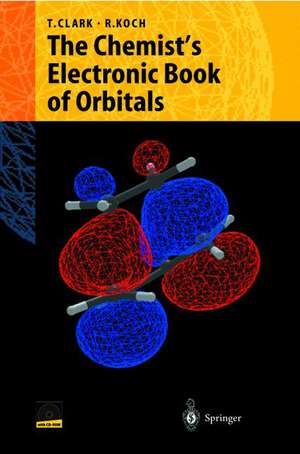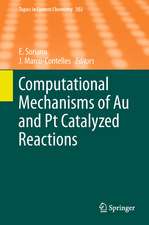The Chemist’s Electronic Book of Orbitals
Autor Timothy Clark, Rainer B. Kochen Limba Engleză Paperback – 6 mai 1999
Preț: 380.45 lei
Nou
Puncte Express: 571
Preț estimativ în valută:
72.80€ • 76.01$ • 60.25£
72.80€ • 76.01$ • 60.25£
Carte tipărită la comandă
Livrare economică 04-18 aprilie
Preluare comenzi: 021 569.72.76
Specificații
ISBN-13: 9783540637264
ISBN-10: 3540637265
Pagini: 96
Ilustrații: VIII, 96 p. 132 illus. With online files/update.
Dimensiuni: 155 x 235 x 6 mm
Greutate: 0.24 kg
Ediția:1999
Editura: Springer Berlin, Heidelberg
Colecția Springer
Locul publicării:Berlin, Heidelberg, Germany
ISBN-10: 3540637265
Pagini: 96
Ilustrații: VIII, 96 p. 132 illus. With online files/update.
Dimensiuni: 155 x 235 x 6 mm
Greutate: 0.24 kg
Ediția:1999
Editura: Springer Berlin, Heidelberg
Colecția Springer
Locul publicării:Berlin, Heidelberg, Germany
Public țintă
GraduateCuprins
Introduction.- Linear Combination of Atomic Orbitals: H2 and He2 - The Simplest Examples; The Effect of Electronegativity; p-Orbitals and pi-Overlap; Combining AOs to Build MOs; The AH2 Walsh Diagram .- Larger Molecules: Ethylene; Cyclopropane; pi-Systems; Hyperconjugation.- Reactions: Lewis Acid/Lewis Base Interactions; Selectivity; Frontier MO Theory; The Woodward-Hoffmann Rules.- Elementary Symmetry: Symmetry Elements; Point Groups; Irreducible Representations and Character Tables; Degenerate Orbitals.- General Information - Installation - Use.- List of Molecules.- Glossary.
Textul de pe ultima copertă
This new electronic textbook introduces chemistry students to the world of orbitals using 3D and VRML representation of molecular orbitals. The electronic components of the book are included - together with the necessary representation tools - in the CD-ROM accompanying the book. A short introduction to the basic chemistry and physics of orbitals enables the reader to use the VRML world of orbitals on the CD successfully. The CD itself contains an extended interactive textbook and a broad selection of classical organic compounds and inorganic complex ligands including their orbitals. In several demonstrations, the student may interactively alter relevant parameters and watch the change in the orbitals' characteristics or take a walk through the 3D-VRML representations of the orbitals.
Caracteristici
Includes supplementary material: sn.pub/extras












![The Double [3+2] Photocycloaddition Reaction](https://i3.books-express.ro/bt/9783642270437/the-double-3-2-photocycloaddition-reaction.jpg)









